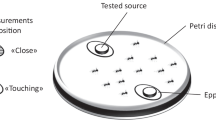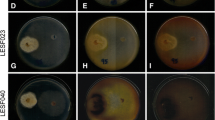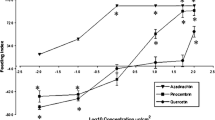Abstract
Four natural products, of varying activity as deterrents of leafcutter attack, were tested for their effects on ant survival and on the growth of the mutualistic attine fungus. The substances were incorporated into an artificial liquid diet for bioassays on the ants or included in an agar culture medium for fungus growth-inhibition studies. Three of the four compounds exhibited deleterious effects on either adult leafcutting ants or their mutualistic fungus, and there appeared to be some correlation between deterrency and activity in these toxicity assays. The implications of these findings for leafcutting ant foraging patterns are discussed.
Similar content being viewed by others
References
Boyd, N.D., andMartin, M.M. 1975. Faecal proteinases of the fungus-growing ant,Atta texana: Their fungal origin and ecological significance.J. Insect Physiol. 21:1815–1820.
Cancilla, D. 1985. Ant-Repellent constituents ofVismea baccifera MS Thesis. University of Iowa, Iowa City.
Cherrett, J.M. 1968. The foraging behavior ofAtta cephalotes L. (Hymenoptera, Formicidae) I. Foraging patterns and plant species attacked in a tropical rain forest.J. Anim. Ecol. 37:387–403.
Febvay, G., andKermarrec, A. 1981. Activites enzymmatiques des glandes salivaires er de l'intestin moyen d'une fourmi attine (adultes et larves):Acromyrmex octospinosus (Reich) (Formicidae, Attini).Arch. Biol. 92:299–316.
Haines, B.L. 1978. Element and energy flows through colonies of the leaf-cutting ant,Atta columbica, in Panama.Biotropica 10:270–277.
Howard, J.J. 1987. Leafcutting ant diet selection: The role of nutrients, water, and secondary chemistry.Ecology 68:503–515.
Hubbell, S.P., andWiemer, D.F. 1983. Host plant selection by an attine ant, pp. 133–154,in P. Jaisson (ed.). Social Insects in the Tropics, Vol. 2. University of Paris Press, Paris, France.
Hubbell, S.P., Wiemer, D.F., andAdejare, A. 1983. An antifungal terpenoid defends a neotropical tree (Hymenaea) against attack by a fungus-growing ant (Atta).Oecologia 60:321–327.
Hubbell, S.P., Howard, J.J., andWiemer, D.F. 1984. Chemical leaf repellency to an attine ant: Seasonal distribution among potential host plant species.Ecology 65:1067–1076.
Hubert, T.D., andWiemer, D.F. 1985. Ant repellent terpenoids fromMelampodium divaricatum, Phytochemistry 24:1197–1199.
Littledyke, M., andCherrett, J.M. 1976. Direct ingestion of plant sap from cut leaves by the leaf-cutting antsAtta cephalotes (L.) andAcromyrmex octospinosus (Reich) (Formicidae, Attini).Bull. Entomol. Res. 66:205–217.
Littledyke, M., andCherrett, J.M. 1978. Defence mechanisms in young and old leaves against cutting by the leaf-cutting antsAtta cephalotes (L.) andAcromyrmex octospinosus (Reich) (Hymenoptera: Formicidae).Bull. Entomol. Res. 68:263–271.
Lugo, A.E., Farnsworth, E.G., Pool, D., Jerez, P. andKaufman, G. 1973. The impact of the leaf cutter antAtta columbica on the energy flow of a tropical wet forest.Ecology 54:1292–1301.
Martin, M.M., andWeber, N.A. 1969. The cellulose-utilizing capability of the fungus cultured by the attineant Atta columbica tonsipes.Ann. Entomol. Soc. Am. 62:1386–1387.
Mudd, A., andBateman, G.L. 1978. Rates of growth of the food fungus of the leaf-cutting antAtta cephalotes (L.) (Hymenoptera: Formicidae) on different substrates gathered by the ants.Bull. Entomol. Res. 69:141–148.
Mudd, A., Peregrine, D.J., andCherrett, J.M. 1978. The chemical basis for the use of citrus pulp as a fungus garden substrate by the leaf-cutting antsAtta cephalotes (L.) andAcromyrmex octospinosus (Reich) (Hymenoptera: Formicidae).Bull. Entomol. Res. 68:673–685.
Quinlan, R.J., andCherrett, J.M. 1978. Aspects of the symbiosis of the leaf-cuttingantAcromyrmex octospinosus (Reich) and its food fungus.Ecol. Entomol. 3:221–230.
Quinlan, R.J., andCherrett, J.M. 1979. The role of fungus in the diet of the leaf-cutting antAtta cephalotes (L.).Ecol. Entomol. 4:151–160.
Rockwood, L.L. 1976. Plant selection and foraging patterns in two species of leaf-cutting ants (Atta).Ecology 57:48–61.
Rohlf, F.J., andSokal, R.R. 1969. Statistical Tables. W.H. Freeman, San Francisco.
Schade, F.H. 1973. The ecology and control of the leaf-cutting ants of Paraguay, pp. 76–95,in J.R. Gorham (ed.). Paraguay: Ecological Essays. Academy of the Arts and Sciences of the Americas, Miami.
Seaman, F.C. 1984. The effects of tannic acid and other phenolics on the growth of the fungus cultivated by the leaf-cutting ant,Myrmicocrypta buenzlii.Biochem. Syst. Ecol. 12:155–158.
Weber, N.A. 1946. The biology of the fungus-growing ants. Part IX. The British Guiana species.Rev. Entomol. 17:114–172.
Weber, N.A. 1972. Gardening ants: The attines.Mem. Am. Phil. Soc. 92:1–146.
Wiemer, D.F. 1985. Natural repellents of the leaf cutter ants.Rev. Latinoam. Quim. 16:98–102.
Author information
Authors and Affiliations
Rights and permissions
About this article
Cite this article
Howard, J.J., Cazin, J. & Wiemer, D.F. Toxicity of terpenoid deterrents to the leafcutting antAtta cephalotes and its mutualistic fungus. J Chem Ecol 14, 59–69 (1988). https://doi.org/10.1007/BF01022531
Received:
Accepted:
Issue Date:
DOI: https://doi.org/10.1007/BF01022531




